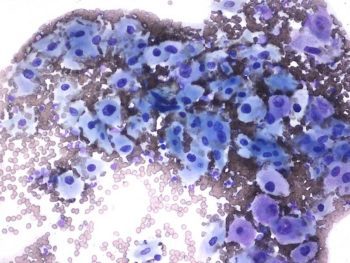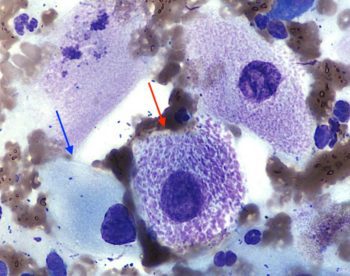28 Jun 2022
Francesco Cian presents the case of an 11-month Labrador retriever with wart-like aplopecic lesions in his latest Diagnostic Dilemmas column.

Figure 1. Nodules on the dorsal paw of the left hindlimb of a young Labrador retriever. Image: Emscote Vets
An 11-month-old Labrador retriever presented for recent onset of two small wart-like, alopecic lesions on the dorsal paw of left hindlimb (Figure 1). The veterinarian performed a fine-needle aspirate (FNA) of the lesions and submitted the slides to an external laboratory for cytological examination.

The aspirates from the two lesions (Figure 2) were similar and showed a main population of large squamous epithelial cells, either individualised or arranged in small groups, on a clear background with frequent red blood cells and few extracellular bacteria.
Cells appeared polygonal and angular, with low nucleus:cytoplasm ratio. Cytoplasm was abundant, pale basophilic (blue arrow) and contained bright fuchsia granulations in a small percentage of cells (red arrow). Nuclei were round, large and central to paracentral, with granular chromatin and poorly visible nucleoli. Few leukocytes, mostly blood-derived neutrophils, were also noted.
The presence of a main population of large, well-differentiated squamous epithelial cells from a warty lesion of a young dog was consistent with papilloma.
Papillomas are classified as non-viral (squamous papilloma) and viral forms. The latter is caused by canine papillomavirus infections and has been associated with multiple syndromes: oral papillomatosis, cutaneous papilloma, cutaneous viral pigmented plaque, footpad papilloma and venereal papilloma.

Cutaneous papilloma is commonly observed in young dogs as single or multiple lesions. It presents as exophytic form, in which the folded epidermis protrudes above the surface of the skin, or inverted papilloma, in which the folded epithelium is contained within a depressed cup-shaped structure. Face, ears and extremities are preferred locations. Spontaneous regression within six weeks to nine months has been reported.